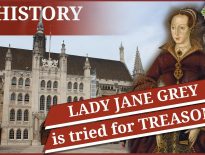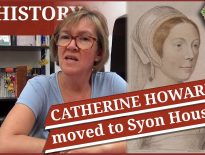On this day in Tudor history, 12th November 1537, the corpse of Queen Jane Seymour, Henry VIII's third wife, was transported by chariot in a procession from Hampton Court Palace to Windsor Castle, in preparation for burial. Jane Seymour's heart and entrails had been buried in the chapel at Hampton Court Palace following her death on 24th October 1537.
Queen Jane's stepdaughter, the Lady Mary, acted as chief mourner for the proceedings.
There was also a commemoration for Queen Jane in the city of London on 12th November 1537.
In today's talk, I give details of the procession, the service at St George's Chapel, Windsor Castle, where Jane was buried, and the commemoration in the city of London.
Also on this day in history:
- 1532 - Henry VIII and Anne Boleyn finally left Calais after being delayed by a Channel fog. They landed at Dover on Thursday 14th November. They had been visiting Calais to meet with the French king, Francis I.
- 1541 - Queen Catherine Howard was examined by members of the King’s Council following Francis Dereham’s claim that Thomas Culpeper had replaced him in the Queen’s affections after her marriage to Henry VIII.
- 1554 – The opening of Mary I’s third Parliament. At this Parliament, a bill was passed allowing the exiled Cardinal Reginald Pole to return to England as papal legate.
- 1555 – Mary I's Parliament re-established Catholicism in England.
- 1555 - Stephen Gardiner, Bishop of Winchester and Mary I’s Lord Chancellor, died. He was laid to rest at Winchester Cathedral in what is now known as the Bishop Gardiner Chantry Chapel. You can find out more about Gardiner by reading the mini bio here.
- 1576 – Death of Sir Edward Saunders, judge. He was buried at Weston under Wetherley, Warwickshire. Saunders' offices included Serjeant-at-Law, Recorder of Coventry, Chief Justice of the King's Bench and Chief Baron of the Exchequer.
- 1586 – A delegation of forty MPs and twenty peers presented Elizabeth I with a petition demanding that “a just sentence might be followed by as just an execution” in the case of Mary, Queen of Scots.
- 1595 – Death of Sir John Hawkins, merchant, shipbuilder, navigator, explorer, slave trader and naval commander, at Puerto Rico on a voyage, with Sir Francis Drake, which aimed to capture Panama. He was buried at sea. Hawkins is known for being the chief architect of Elizabeth I's navy, and he was knighted for gallantry after serving as Vice-Admiral during the Spanish Armada.



Leave a Reply